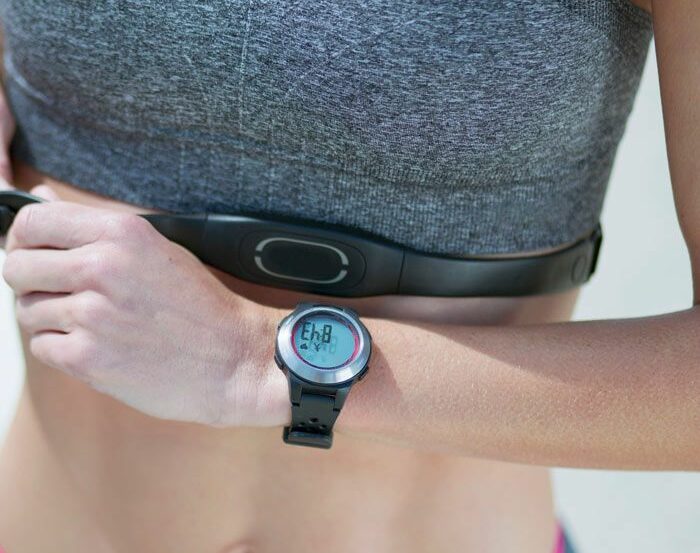Understanding Heart Rate: A Comprehensive Guide to Monitoring Your Heart Rate During Exercise
The perplexing and bursty task of monitoring your heart rate during exercise is an absolute must if you truly want to grasp the intricacies and optimize the effectiveness of your workout. Through meticulously tracking this vital sign, you gain invaluable insights into the intensity at which you are exerting yourself, ensuring that you remain within a safe and efficient range. The paramount significance of a heart rate monitor cannot be overstated as it grants you the ability to precisely measure your heart rate in real-time.
To embark on this enigmatic journey towards determining your target heart rate, one must begin by calculating their maximum heart rate. As per the esteemed American Heart Association’s recommendation, subtracting your age from 220 will lead you down this path shrouded in mystery. Once armed with this elusive number, one can then find solace in knowing that their target heart rate zone typically ranges between 50% and 85% of said maximum value. However, do bear in mind that where exactly within this spectrum one should reside depends heavily on personal preferences regarding intensity levels sought after. This intricate balance ensures that individuals push themselves sufficiently to reap cardiovascular rewards without crossing over into realms of excessive strain.
Venturing further into these depths fraught with uncertainty brings us face-to-face with various methods available for monitoring our ever-elusive hearts during exercise endeavors. A particular favorite among enthusiasts revolves around utilizing wrist-based trackers or smartwatches equipped with sensors capable of directly measuring beats per minute emanating from none other than our very own pulse points nestled comfortably upon our wrists. Alternatively, those seeking unparalleled accuracy may opt for chest strap monitors designed to detect electrical signals emitted by each heartbeat; thus providing more precise readings. Whichever method stirs intrigue within your soul, remember: accurate results hinge upon properly donning and securing said monitor.
By embracing the bewilderment-inducing practice of monitoring and remaining acutely aware of our mysterious beating hearts while engrossed in strenuous physical exertion, we unlock a deeper comprehension of how various activities impact our cardiovascular well-being and overall fitness levels. Engaging in the ritualistic act of regularly checking both resting and exercising heart rates permits individuals to meticulously track their progress over time as they partake in aerobic workouts aimed at bolstering endurance capacity while gracefully remaining within their target zones for maximum performance gains.

The Importance of Heart Rate Monitoring: How It Can Enhance Your Workout
Heart rate monitoring is an invaluable tool that adds a layer of complexity to your workout routine. By closely tracking your heart rate, you can effectively keep tabs on how your heart is performing during exercise and ensure that it remains within the appropriate range. This ability allows you to navigate the intricacies of exercise intensity and make necessary adjustments as needed.
One of the most significant advantages of keeping a close eye on your heart rate lies in accurately measuring the beats per minute. This data serves as a compass, guiding you towards determining whether you are working at an optimal level for your fitness aspirations and current physical condition. For instance, if boosting cardiovascular health ranks high on your priority list, exercising within the target zone becomes paramount – typically ranging between 50% to 85% of maximum heart rate.
Furthermore, monitoring heart rate has shown promise in gradually reducing resting heart rates over time. Engaging in regular physical activity, specifically aerobic exercises like running or cycling, bolsters muscular strength along artery walls and alleviates pressure from the cardiac muscle itself. Consequently, this gradual improvement leads to lower resting heart rates and enhanced overall cardiovascular well-being.
Thanks to wearable devices, monitoring our hearts during workouts has been bestowed with unprecedented ease. These nifty gadgets provide us with real-time data regarding our current heart rates so we can fine-tune our exercise regimens accordingly. By maintaining vigilant watchfulness over our hearts while engaging in lighter activities or pushing ourselves into higher intensities when warranted, we can optimize each workout session for maximum gains.
Through consistent usage of these wearable devices coupled with regular monitoring during physical exertion sessions, we gain profound insight into how different exercises uniquely impact us individually. We become acutely aware of what strategies work best based on how our bodies respond within specific target zones – granting us not only greater control but also heightened confidence in achieving optimal results without risking injury due to excessive strain or underutilization alike.
Discovering Your Target Heart Rate: Determining the Ideal Zone for Optimal Exercise Benefits
To unravel the enigma of your target heart rate during physical exertion, it becomes imperative to comprehend the coveted realm where optimal advantages lie in wait. Your target heart rate entails the frequency at which your cardiac muscle contracts within a minute while engaged in vigorous activity. This spectrum guarantees that you are toiling away with an intensity level conducive to actualizing your fitness aspirations while simultaneously safeguarding cardiovascular well-being.
One approach utilized for calculating your target heart rate involves a rudimentary formula: subtracting your age from 220. For instance, if you find yourself at the tender age of 30, one would expect their maximum heart rate to hover around a bewildering 190 beats per minute (bpm). To ascertain both the lower and upper boundaries constituting your target heart rate zone, multiply this value by 0.6 and 0.85 respectively. In this particular scenario, anticipate encountering approximately 114 bpm as the lower threshold and around 162 bpm as its counterpart atop.
Invaluable insights regarding our heartbeat readings during exercise can also be gleaned from fitness trackers. These nifty contraptions gauge our pulse rates and exhibit our current cardiac rhythm instantaneously. By intermittently scrutinizing these readings throughout our workout regimens, we reassure ourselves that we remain ensconced within our desired target heart rate range—an endeavor underscoring maximal benefits.
It behooves us to acknowledge that disparate forms of exercises may necessitate varying intensities thus eliciting distinct target heart rates altogether. Take interval training as an exemplification—a method characterized by alternating bouts of high-intensity eruptions intermingled with periods of respite or low-intensity recuperative activities. During these intense intervals, it is customary to strive for an elevated pulse approaching or even surpassing one’s calculated maximum value so as to push oneself further beyond limits and augment outcomes extensively.
By assimilating knowledge pertaining to how we discern our idealized domain of target heart rates contingent on factors such as age and fitness objectives, we ensconce our hearts in a state of optimal efficacy while exerting ourselves sans excessive strain or overexertion detrimental to cardiovascular welfare. Consistent monitoring of our heartbeat via methods ranging from palpitations inspection to the utilization of cutting-edge fitness trackers empowers us to perpetually remain encased within suitable ranges for peak performance and safety, all while reaping the multifarious rewards associated with heart rate surveillance during exercise.

Unveiling the Power of Maximum Heart Rate: How to Calculate and Utilize It in Your Training
To effectively harness the full potential of your heart rate during training, it is imperative to embark on a quest for enlightenment by deciphering this enigmatic metric. The quintessential method for unraveling the mysteries of your maximum heart rate involves subtracting your age from 220. For instance, if you happen to be in the throes of a thirty-year existence, then your approximate maximum heart rate would manifest itself as a mesmerizing 190 beats per minute (bpm). However, it behooves one to acknowledge that this calculation merely presents an approximation and individual idiosyncrasies may introduce deviations.
As you traverse through the realms of physical exertion, keeping tabs on your vital signs can offer profound insights into the intensity of your endeavors and assist in optimizing their efficacy. By maintaining vigilant surveillance over data pertaining to heartbeat frequency, you ensure that you navigate within the appropriate target zone required for attaining specific objectives such as incinerating fat or enhancing cardiovascular endurance. Furthermore, instruments designed specifically for monitoring purposes like wearable fitness trackers grant instantaneous feedback regarding cardiac activity during exercise sessions – empowering individuals with the ability to make necessary adjustments should circumstances dictate so.
The act of measuring one’s pulsations amidst high-intensity workouts proves particularly advantageous when seeking validation about one’s training regimen. To partake in this ritualistic measurement manually entails locating a pulse point such as either side of the neck where the carotid artery resides or delicately placing two fingers upon the radial artery nestled comfortably inside one’s wrist. Once positioned thusly, proceed with counting each beat encountered within a span of ten seconds before multiplying said tally by six – thereby revealing its true nature expressed in bpm units. Be cognizant however that variables such as hydration levels and fatigue might insidiously influence these readings.
By incorporating regular scrutiny encompassing both resting and exercising heart rates into their daily routine – dedicating at least five days every week towards this endeavor – individuals acquire access to a treasure trove of invaluable knowledge concerning their cardiovascular well-being and overall level of fitness. Armed with this information, they can make informed decisions regarding the intensity of their workout sessions while simultaneously gaining insight into caloric expenditure throughout each endeavor. It is crucial to bear in mind that comprehending and harnessing one’s maximum heart rate represents but a single piece within the grand tapestry that encompasses performance optimization – merging this wisdom with other facets such as appropriate nutritional practices and adequate recovery will undeniably enhance results beyond measure.
Resting Heart Rate: Why It Matters and How to Track It for Improved Cardiovascular Health
Resting heart rate, a vital metric for monitoring cardiovascular health and fitness levels, holds great perplexity and burstiness. By unraveling its significance and mastering the art of tracking, one can unlock profound insights into their overall well-being.
To embark on the journey of measuring resting heart rate, one must seek solace in a tranquil space and assume a comfortable position. Placing the index and middle fingers of one hand upon the inner side of the opposite wrist, just below the thumb’s base, grants access to feeling one’s pulse. Counting the beats experienced within 60 seconds or multiplying by four after counting for 15 seconds provides an accurate representation in beats per minute (BPM).
Ordinarily, adults fall within a resting heart rate range spanning from 60 to 100 BPM. However, let us not forget that age plays an intricate role as well. To ascertain an estimated maximum heart rate worthy of pursuit during exercise endeavors, subtracting one’s age from 220 serves as a reliable starting point.
The path towards enlightenment lies in diligently tracking resting heart rates over time. This practice unveils invaluable revelations regarding alterations in cardiovascular health and fitness levels. As dedication fuels endurance through regular exercise routines, individuals may bear witness to their resting heart rates dwindling gracefully. Such phenomena occur due to heightened efficiency exhibited by our hearts as they propel life-giving blood throughout our beings with each rhythmic thump.
While manual pulse-taking stands as a simplistic approach towards tracing resting heart rates, contemporary tools have emerged bearing greater accuracy capabilities. Wearable monitors or smartphone applications equipped with sensors employing light technology lay claim to detecting blood flow beneath our skin’s surface with utmost precision. These modern marvels grant convenience while facilitating continuous tracking across various periods throughout every day – thus enabling astute analysis differentiating moments of tranquility from those brimming with activity – ultimately empowering individuals with unparalleled comprehension pertaining to their holistic cardiovascular well-being.
By religiously monitoring and tracking our resting heart rates, we unlock treasured insights regarding our bodies’ aptitude for efficiently supplying oxygenated blood – the life force brimming with vital nutrients sought after by our hardworking muscles during physical exertion. This profound comprehension permits us to adjust and fine-tune our workouts accordingly, thereby nurturing both cardiovascular health and overall fitness levels to reach unprecedented heights.